What’s the Deal with Simple Syrup?
You may have heard the term “simple syrup” or “sugar syrup” in a drink recipe, or overheard a bartender mention just “simple”. If you’re wondering what it is, you’re in luck – you’ve found the ultimate guide! Here’s what’s covered here. (Click to jump straight to each section!)
And if you want to really learn more about how to completely transform your cocktails with syrups, sign up for our Crafting Cocktail Syrups Course!
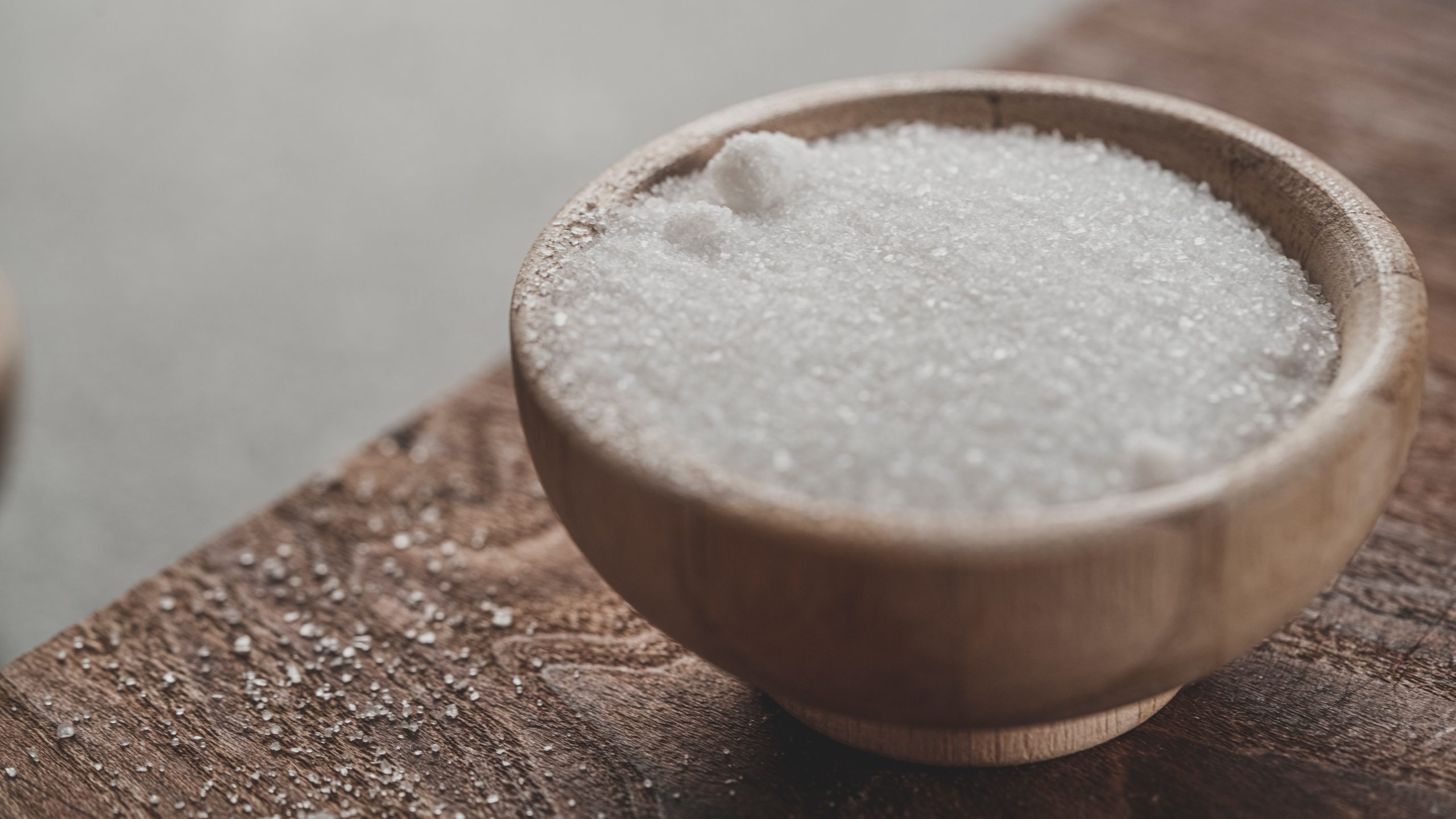
Photo by Faran Raufi via www.unsplash.com
What is Simple Syrup?
Simple Syrup, also known as “sugar syrup” (and sometimes “sugary syrup”) is a syrup made from dissolving white granulated sugar into an equal amount of water. Yep, that’s all! (I told you it was “simple”!)
Simple Syrup is (by far) the most common sweetener used by bartenders for cocktails. The reason is no secret – when drinks are cold, it takes longer for sugar to dissolve into them. Creating a sugar syrup in advance means there’s no risk of sugar granules left in your cocktail (or other cold drink) when served. It’s also for this reason that simple syrup is the perfect sweetener for other cold drinks like iced tea, and why (with the increasing popularity of cold coffee drinks) hip coffee shops are starting to replace their sugar packets with simple syrup.
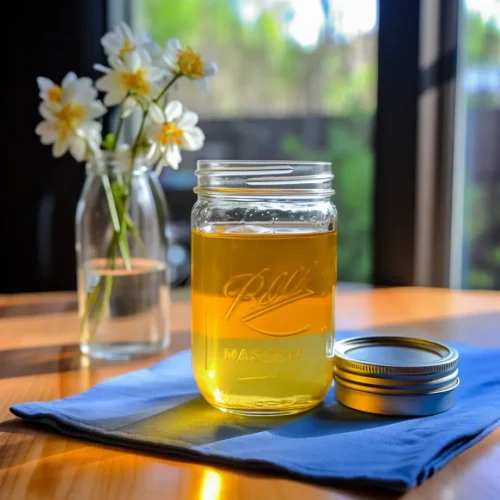
Copyright A Bar Above
Should I Buy Simple Syrup or Make it Myself?
Good question! There’s a reason companies love to sell you simple syrup, and that’s because it’s SO easy and cheap to make that they can easily make a huge profit!
I would always recommend making simple syrup yourself for the following reasons:
- It’s incredibly easy to do. (See: How to Make Simple Syrup below.)
- The only ingredients required are white sugar and water, two things you almost certainly have on hand already.
- It’s much cheaper to make it yourself! (Check this out – $7+ each for a 33oz bottle of water and sugar! Yikes.)
- You can make exactly how much you need, so you won’t have to worry about it going bad or finding a place to store it. (See this section for tips on storing your syrup.)
- You’ll know what’s in it. Many store-bought brands add preservatives like citric acid or other unpronounceable ingredients. No thanks.
How to Buy Simple Syrup
If you DO prefer to buy it (no judgment, no worries!) here are some things you should look for in a good quality syrup: Look for a simple syrup that’s literally just sugar (or a type of sugar) and water.
Common Ingredients to Avoid:
- Preservatives and Fillers: Many store bought simple syrups include additives like citric acid or other preservatives. While preservatives will make your syrup last longer, they can also alter the taste. If you want to make your syrup last longer, there are some tricks to do that without altering the flavor.
- For some reason (lost on me), some syrups also include coloring. Maybe perfectly clear syrup doesn’t look “syrupy” enough for some folks (?), but for me, natural or artificial color is just unnecessary.
- High Fructose Corn Syrup: HFCS is a very inexpensive sweetener, so some of the cheaper simple syrups like to use it because it’s cheap to buy. Unfortunately it does change the flavor of the syrup and is often correlated with syrups that are actually too sweet. The risk here is that you use a HFCS-based simple syrup, your recipes won’t turn out right.
Unfortunately, I’ve found that syrups which meet the above criteria are also usually the most expensive ones. So again – if it’s possible for you to make it yourself, that might be a better choice. If not, then try to follow the suggestions above and you’ll be just fine.
We’re just a bunch of regular people who love making classy drinks. Join us!
How to Make Simple Syrup
Making simple syrup is incredibly easy to do! Here goes:
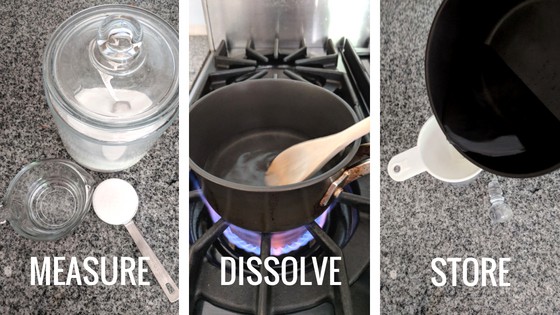
Recipe for Simple Syrup
If your recipe calls for “simple syrup”, this is your recipe! This one is also known as “sugar syrup”, “one to one” or just “simple”.
Ingredients:
- 1 part Sugar (Yep, plain white granulated sugar)
- 1 part Water
Instructions:
- Combine ingredients in a saucepan and turn on the heat.
- Stir until the sugar has completely dissolved and remove immediately from the heat.
- Decant into a sterile container and cool before using.
Warning: Don’t Measure Together!
It’ll be tempting to measure your sugar and water in the same container, by adding either the water or the sugar first, then filling adding the other ingredient until the overall total is correct. Don’t give in to temptation!
Since sugar granules actually have some space between them, doing this will not give you the correct 1:1 ratio. Instead you’ll actually add a bit too much water. Measure your water and sugar separately for the perfect ratio.
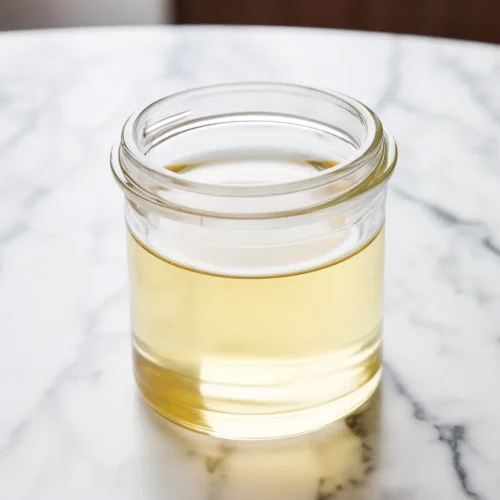
Copyright A Bar Above
Cold vs. Hot Methods:
In reality, you don’t need to heat your syrup. Sugar dissolves beautifully in cold water just fine, it just takes a few minutes of stirring. I tend to be impatient, so I go with the warm approach – but you do you!
There is no downside to the “cool” method except a bit more stirring time. (And in fact if you need cold temperature syrup right away, it may be quicker to use the cold method so you don’t have to wait for it to cool.)
Simple Syrup Ratios
Bartenders love to use different ratios of sugar to water in their simple syrups. It’s usually pretty easy to figure out which is which, but here’s a guide just in case:
- “Simple Syrup”, “Simple” or “One to One” – Use the ratio above, 1 part sugar to 1 part water.
- “Rich Simple”, “Rich Simple Syrup” or “Two to one” – use a ratio of 2 parts sugar to 1 part water.
- “X to one” – for example “one and a half to one” or “one to two” – assume the first number is the amount of sugar and the second is water. So “one and a half to one” would be one and a half parts sugar to one part water. Likewise “one to two” is one part sugar to two parts water.
Comparing Simple Syrup and Rich Simple Syrup in Cocktails:
If you’re wondering which syrup you should use in your cocktails, you may enjoy this video we made discussing the differences between the two and how it affects the final cocktail. Warning: This is literally the first video we ever created. So the production quality is not great (and doesn’t Chris look young?) But the information is still good!
Flavored Simple Syrups
One of the beautiful things about simple syrup is the fact that it is completely unflavored. This makes it a beautiful blank slate! Flavored syrups are a great way to add flavor to everything from cocktails to teas and even baked goods like cake or cookies. If you’re interested in creating flavored syrups, here are some tips, tricks and ideas for inspiration.
Depending on the flavor you’re hoping to add to your syrup, you may choose one of several different methods to work with. Here are a few methods to consider:
Infused Simple Syrup: for Concentrated Flavors like Tea, Spicy Peppers or Spices
For spices, tea, or other ingredients with concentrated flavor and low water content, infusion may the best approach. (Check out this in-depth guide to infusions here.)
- Chop your flavoring ingredient into small pieces (if necessary – if using tea leaves or spices that may already be done for you.)
- Add your ingredient to your syrup and stir.
- Seal and set aside in your fridge to infuse.*
- Once you are happy with the flavor, fine-strain and use!
*For very strong flavors like teas or hot peppers, check the flavor every few hours. For other spices or subtler flavors like vanilla, cardamom, or dried fruit, it will take a bit longer. Taste every day or two until you reach the flavor you’re looking for.
Muddling or Macerating: For Ripe Fruit with High Water Content
It can be a bit tricky to work with fruit and syrups because the fruit bring such a high water content, and an unknown amount of sugar. But the final product is worth the extra effort!
Muddling or Blending Fruit with Simple Syrup
For Fruits with a high water content like berries, melon, stone fruit, etc, consider simply muddling the fruit into your syrup.Chop the fruit into 1″ or smaller pieces and muddle in the bottom of a bowl or cocktail shaker. Combine with syrup and stir. Add fruit and continue to muddle to taste. Fine-strain out the fruit when you’re happy with the flavor.
If you’re lazy like me, I’ll sometimes take this approach: Add a small portion of your syrup and your flavoring ingredient to a blender and blend. Then fine-strain the bits from your blended mixture to create an ultra-concentrated syrup. Add it back to the rest of your unflavored syrup until you’re happy with the flavor.
Macerated Fruit Syrup
Another method for fruit: While this isn’t technically a “simple” syrup, if you’re looking to make a sugar syrup with a fruit that has a high water content, I’d actually recommend maceration instead. Simply chop the fruit into small pieces in a bowl and add sugar. Stir to coat, cover, and let it sit for a couple of hours. The sugar will help draw the liquid out of the fruit and when you return, you’ll find a bowl of fruit chunks swimming in delicious fruity syrup.
Calibrating your Sweetness
Note that for both of these methods, you will want to taste check the sweetness of your syrup as it will likely be watered down by the water in the fruit, but may also become sweeter if the fruit is sweeter as well. Try to add sugar or water as needed to retain the same level of sweetness as your original (unflavored) syrup. (You may need to make a small amount of unflavored syrup for comparison. Don’t worry, it’ll go to good use!
Simmered Syrup for Even More Flavor
It’s well known that heat speeds up and accentuates the infusion process, so it’s no surprise that heating the syrup and your flavoring ingredient is another great approach for adding flavor. This works especially well for dried spices, teas, and fruit (if you’re looking for more of a “cooked” fruit flavor.) The method is similar to the above, but adds an element of heat:
- Add your unflavored syrup and chopped flavoring ingredient to a saucepan
- Bring up the heat to just below a boil and stir frequently. (You want to avoid a boil as that will evaporate the water and make your syrup too sweet.)
- Taste (carefully) and continue to simmer and stir until the desired flavor is reached.
- When you’re happy with the flavor, remove from heat immediately, strain and store.
Another Throwback Video:
If you’re curious to learn more about how these different approaches affect the flavor of your syrup, you may appreciate another ancient video from our archives. In this video Chris compares the results when adding mint to syrup at different stages in the process.
Inspiration for Flavored Simple Syrups
Looking for ideas? There are thousands of great syrups that you can try (especially by combining flavors below). But here are some ideas to get you started.
Fruit Flavors:
- Berries (Strawberries, Raspberries, Blackberries, etc.)
- Stone Fruit (Apricots, Peaches, Plums, etc.)
- Melon (Watermelon, Honeydew, Cantaloupe)
- Tropical Fruit (Pineapple, Mango, etc. ) Note – I’ve never tried Banana, but it could work!
- Apples
- Pears
Herbs, Spices & Tea:
- Pepper (Black peppercorns, pink peppercorns, crushed red pepper, serrano, jalapeño, etc.
- Leafy Herbs like Mint, Basil, Oregano, or Thyme
- Dried spices like Cardamom,
- Ginger
- Tea like Chamomile, Earl Grey, or virtually all others.
- Cocoa nibs and / or Coffee Husk
Simple Syrup Alternatives
If you don’t have simple syrup on hand and you need it for a recipe, the first thing I’d consider is making it yourself. But if you’re lacking white sugar or looking for a lower calorie alternative, you’re not completely out of luck!
Alternative Sugars:
Replace your white sugar with these other types of sugar to create some delicious alternatives.
- Brown Sugar Syrup: Like simple syrup in sweetness but brings a delicious dark molasses flavor. Great for cocktails with aged spirits like whiskey.
- Demerara (or Turbinado) Syrup: Much lighter than brown sugar but still has some of those molasses undertones. Flavor is more like a light caramel.
- Honey Syrup: Use a 3:2 ratio of honey to water. Lovely aromatic honey flavor that pairs beautifully with most spirits, but especially aromatic choices like gin.
- Agave Syrup: Use a 1:2 ratio of agave nectar to water to create the perfect sweetener for cocktails made with tequila. (Note: Check your bottle of Agave Nectar – it may already be watered down into syrup!)
- Maple Syrup: Use a 1:2 ratio of maple syrup to water to create an incredibly delicious maple cocktail syrup. Great with whiskey and rum!
Check out this video for a taste test comparison of these options to help you choose!
Low Sugar Alternatives:
If you’re trying to reduce your sugar intake, it can be tricky to work with syrups. We did some testing on various sugar substitutes in cocktails, and here were our results:
- Simple Syrup made with “Equal” Sweetener: The syrup did not balance out our “test” cocktail, which still tasted very sour and alcoholic. Also came with a pretty strong “artificial sweetener” aftertaste.
- Simple Syrup made with “Sweet ‘n Low”: Definitely balanced out the lemon juice and sweetened the cocktail considerably. There was still a slight “Diet Soda” after-taste after a few seconds.
- Simple Syrup made with “Splenda”: Somewhere in between the others – it did take some of the edge off, but not enough to really balance the drink. This syrup did have the least aftertaste of the three.
So if you must avoid sugar altogether, we found the best taste with “Sweet ‘n Low” out of the three we tested. That said, you may be better off with a cocktail that avoids sugar altogether like a martini or Vodka Soda!
Watch the whole video here:
Storing your Syrup: Pro Tips for keeping it fresh!
Now that you have your batch of delicious homemade simple syrup (or honey syrup, or mint-flavored syrup, etc.), you’ll want to keep it fresh as long as possible. The good news is the high sugar content in any syrup will act as a natural preservative to help keep it from going bad. But it won’t keep forever. Here are some tips for keeping your syrup fresh for as long as possible:
How long is Simple Syrup Good in the Fridge?
Thanks to Camper English’s experimentation, I can answer that question easily:
- Simple Syrup is good for about 1 month in the fridge.
- Rich Simple Syrup (2:1) lasts about 6 months (yes, 6 times as long!)
Stretching it Out: How to make your Syrup Last Longer
- Consider making “Rich” (2:1) Simple Syrup instead of “standard”. This higher sugar content syrup has stronger preservative characteristics and is also sugary enough that it does not freeze completely solid in the freezer (at least, not in mine!) So you can store it in the freezer long-term and just use it as needed.
- Be sure to sterilize the container you’ll be storing your syrup in. Douse your jar or bottle in boiling water to quickly sterilize it before adding your syrup. This starts you off on the right foot without giving mold the head start.
- Add Vodka. Yep, in the same article, Camper English found that adding a small portion of vodka to his simple syrup tripled its shelf life in the fridge. (Of course, this is not a good option if your syrup will be used in something non-alcoholic or served to children!)
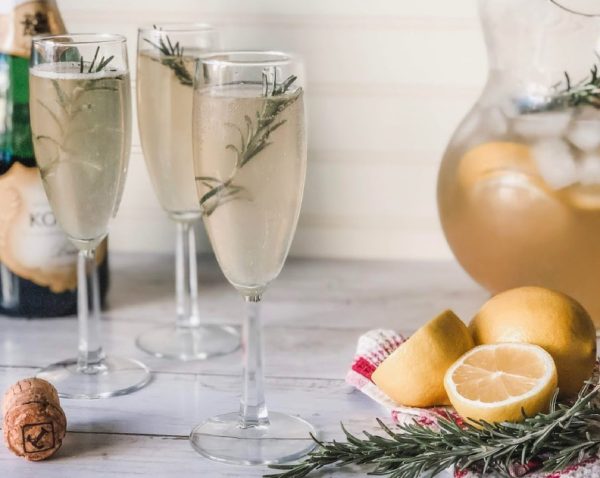
Photo by Katie Rosario via www.upslash.com
Can you Freeze Simple Syrup?
Absolutely! It won’t do your syrup any harm to be stored in the freezer, but if you make it with the 1:1 ratio, it’s likely to freeze solid. As I mentioned above, that’s why you might consider 2:1 “Rich” simple syrup, as it doesn’t freeze completely solid and you can use it immediately for cocktails without waiting for it to thaw.
Has my Syrup gone Bad?
If it’s been more than the shelf lives listed above, chances are pretty good your syrup is no longer good. But if you’re not sure how long it’s been, here are two tests I recommend:
- Is it clear? If your syrup looks cloudy or moldy, that’s a sure sign that it’s past its prime. Syrups should generally not be cloudy in appearance.
- The “Squeezy Bottle Test”. (I made this one up, can you tell?) Put your syrup into squeezy or flexible bottle and cover the top with your finger. Give it a shake. If any pressure builds and the bottle “spits” out air when you remove your finger, it’s toast.
- Does it matter? Simple syrup is so easy and cheap to make, I say don’t risk it. Chuck the questionable syrup and make a new batch.
That’s a wrap! Hopefully this article has answered any and all questions you ever had about the bartender’s favorite sweetener. If not, leave your questions in the comments below and we’ll answer them as they come up (or add them to the article!)

We’re just a bunch of regular people who love making classy drinks. Join us!

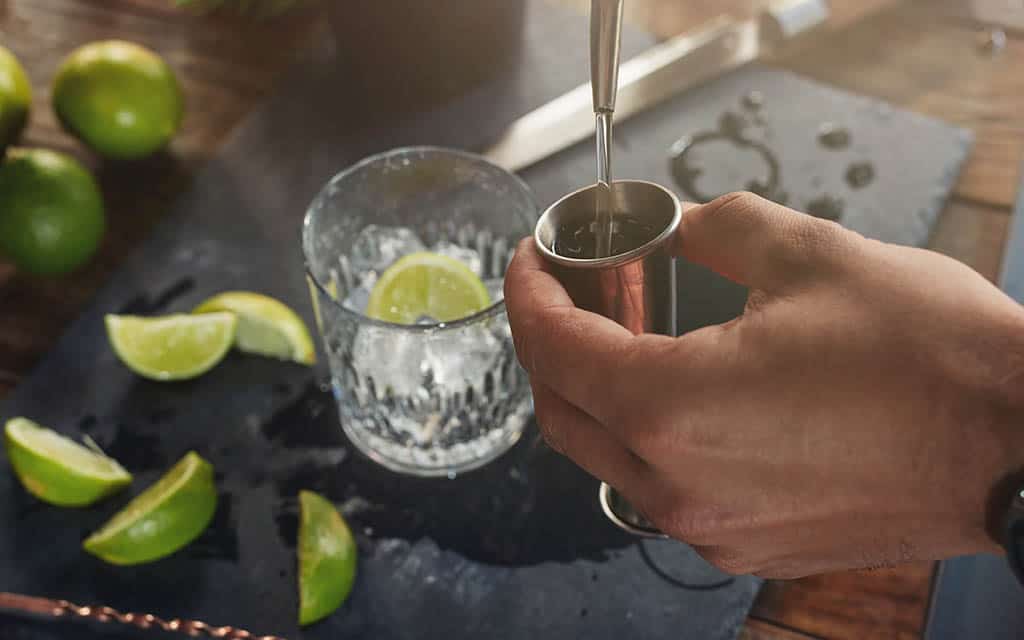
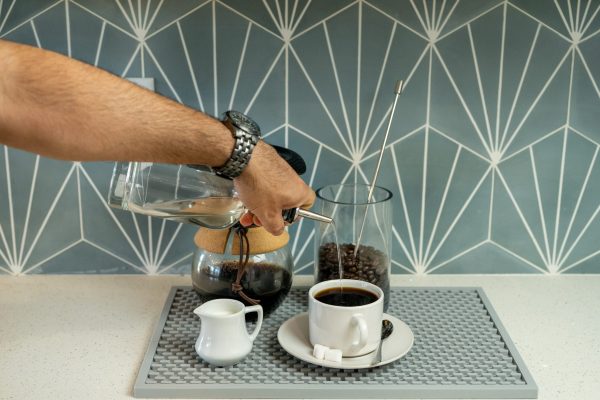



YOU ARE TOTALLY WRONG, THE REASON THE RICH SYRUP IS BETTER IN YOUR DRINK THAN SIMPLE SYRUP ITS BECAUSE YOU MADE ALREADY THE SIMPLE SYRUP TOO SWEET IN THE FIRST PLACE, THEN YOU MADE ANOTHER BIG MISTAKE ON THE AMOUNT YOU PLACED OF RICH SYRUP, SINCE YOU ARE ASSUMING THAT RICH SYRUP IS THE DOUBLE AMOUNT OF SWEET COMPARED TO SIMPLE SYRUP SINCE ONE TAKES TWICE THE SUGAR WITH THE SAME AMOUNT OF WATER THAN THE OTHER,,,WELL THEN,,,, YOU ARE TOTALLY WRONG AGAIN. RICH SYRUP IS ONLY 67 % SWEETER THAN SIMPLE SYRUP,,THAT IS WHY YOUR DRINK TASTED BETTER WITH RICH SYRUP, SINCE YOU MADE IT TOO SWEET WITH SIMPLE SUGAR. YOU NEED 3 PARTS OF SUGAR TO ONE PART OF WATER TO ACTUALLY EQUAL 25 ML OF RICH SYRUP TO MATCH THE 50 ML OF SIMPLE SYRUP,,,THAT IS THE REAL MATHS. ALSO, ITS BETTER TO USE THE SIMPLES SYRUP THAN TO USE THE RICH SYRUP SINCE EVERY DROP OF MISTAKE WITH RICH SYRUP WILL MAKE A MAJOR DIFFERENCE IN SWEET COMPARED TO THE OTHER ONE WHICH NEUTRALIZES THE DRINK.
Thanks for your comment! Personally I think every recipe is different, and it’s important to choose the type of Simple Syrup that suits the recipe. You’re absolutely right – Simple Syrup has more water than Rich Simple Syrup, and you will definitely want to adjust your recipe accordingly!